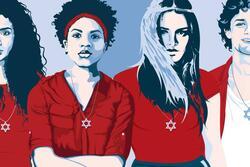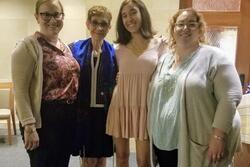Am I Welcome at the Wall?
The first time I visited the Kotel (Western Wall), I cried. I know, this is nothing unusual. This historic place often invokes intense spiritual connection or deep reflection from its visitors, moving them to tears. I was certainly overcome by emotion, but for a completely different set of reasons. I felt shock, frustration, confusion, and anger. This place, a site I had known to be a hub of Jewish connection, appeared before me as the antithesis of what I knew Jewish connection to be.
I stood back from the wall, just before the start of a green fence that separated women from men. My father and brother excitedly marched ahead to the left side of the fence where circles of men covered by tallit (prayer shawls) and black coats danced in circles, singing and rejoicing in the Sabbath.
I stayed put, staring into the area to the right of the fence. There, some woman quietly whispered their prayers into the wall, while others chased after toddlers or rocked babies in their arms. Many of the women pressed their faces against the fence, peering between the slats to observe the men’s rituals. None of them danced. None of them sang. In fact, very few of them even seemed to be there for themselves. It became clear to me that the left side of the wall was for celebrating Shabbat and the right side was an afterthought. The women's side was meant to be quiet, meant to keep the children contained. It was not home to the type of Jewish matriarchal ruach (spirit) that I had grown up with.
Judaism has always been a part of my life that opens doors. It has been a source of connection between family and friends, a catalyst for curiosity and questioning, and a home base for me to explore my identity. What I saw before me seemed to be a type of Judaism that boxed people in. I saw it separate families, silence women, and shepherd individuals into conformity. It irked me to see so many women who would rather sit on the sidelines and watch their husbands and fathers celebrate than take ownership of their own Jewish space. In that moment I could not articulate the reasons for my frustration, but my body knew it did not like this version of Judaism. I stood, stared, and cried.
I now see that for many women, embracing a traditional woman’s role within a Jewish family is their way of living a Jewish lifestyle. This model of Judaism dominated the Kotel during my visit, and as I stared ahead at the wall it was clear: this was not a model that I fit into.
I had to make a decision, to walk back from the Kotel and allow this mold to force me out of spaces that I am connected to, or walk forward, breaking the mold. Breaking the mold seemed to be the right thing to do. As a self-identified social justice advocate, I believe that stepping forward is almost always better than stepping back.
I walked ahead, red-eyed and clothed in baggy garments (the only outfit I could find that would cover my body enough for this Orthodox setting). I stepped up to the wall beside a girl who looked to be about the same age as I, thirteen, only her long skirt and white long-sleeved shirt fell naturally on her. Her prayer book seemed to be just an extension of her body as she davened (prayed). I, on the other hand, was bookless and making up my ritual as I went. I pressed my hands against the wall for a moment, breathing in and out slowly. I tried my best to tune out the unsettling scene around me and just take in the magnificent ancient stones before me. It didn’t work. Out of the corner of my eye, I saw the girl beside me turn her head, looking at me with her eyebrows raised. Her expression blatantly read, “What are you doing here? You don’t belong.”
I left the Kotel that day puffy-eyed and angry. That visit was my first confrontation with traditional Judaism. It made me realize that Jewish spaces are not always going to hold the type of Judaism that I identify with. And that’s just the way it is. I felt let down by this realization, but I was determined not to be deterred. I wanted to continue to take steps forward, coming back to the Kotel and exploring the range of Jewish spaces and styles of Judaism that are out there while taking up my space as a non-traditional Jewish individual—even if it meant feeling like a fish out of water. The next time I went to the Kotel, I knew that if I wanted to get anything positive out of the experience, I would have to compromise.
I wore a red dress, long enough for the setting but just bright and badass enough for me. I let go of the expectation that this space would look the way I wanted Judaism to look. I accepted that it was Judaism nonetheless. I knew I wouldn’t perfectly fit in with everyone in the crowd, I wouldn’t necessarily look like them or act like them. I told myself that I belonged there nonetheless, and that my form of Judaism was just as valid in that space. I even prepared a passive-aggressive smile to flash at anyone who dared to give me another dirty look.
Jewish spaces will never be tailor-made for me or for anyone else. But isn’t that kind of the point? We are known as Israelites ,which roughly translates to “those who struggle with G-d.” Judaism is supposed to make us struggle, think, and process. Now, whenever I am presented with a type of Judaism that I am unfamiliar or uncomfortable with, I know that the most Jewish thing I can do is walk forward, processing and critically thinking every step of the way.
This piece was written as part of JWA’s Rising Voices Fellowship.








when we went during Shavuot we were obstructed by all the baby carriages. An info woman told me she was often drafted as baby sitter. On the other hand, it was the only time i ever got to touch the wall.
Love this!